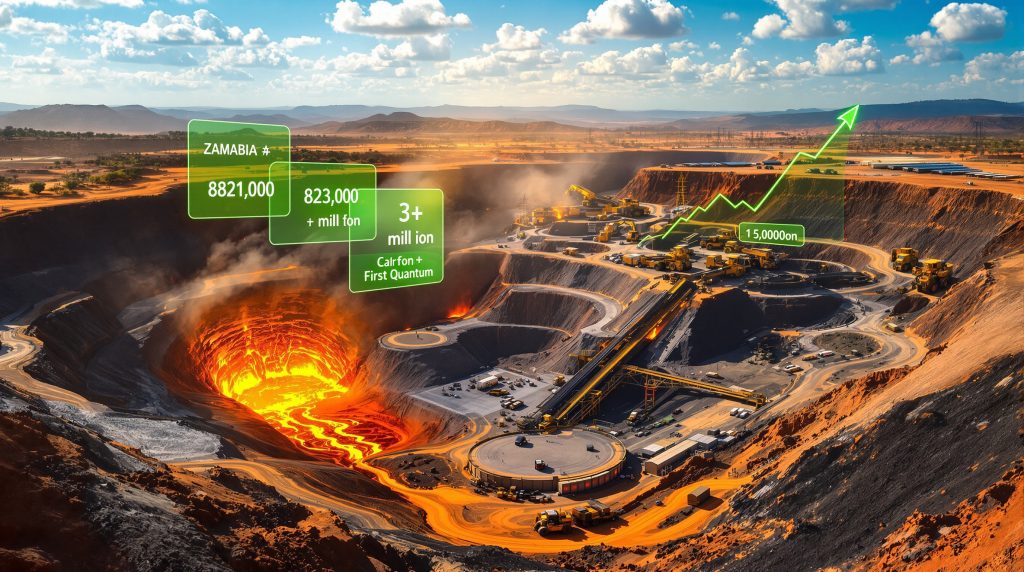Zambia's Copper Mining Boom: Capitalizing on Global Demand
Zambia is strategically positioning itself as a key global copper supplier amid surging prices and growing demand. The copper-rich nation is on track for a historic production milestone in 2025, targeting output to exceed one million tonnes for the first time in its century-long commercial mining history. This production surge comes at an opportune moment as global copper prices have risen more than 20% this year, driven by supply disruptions at major mines worldwide and increasing surging copper demand.
The significance of Zambia's copper mining expansion extends beyond its borders, as it emerges as one of the few major copper-producing countries increasing output while others face serious disruptions. Industry analysts are closely monitoring this development, recognizing it as a potential shift in global copper supply forecast dynamics.
Zambia's Copper Production Trajectory
Current annual production stands at approximately 821,000 tonnes as of 2024, according to Bloomberg data. This output represents the culmination of steady growth in recent years but remains just the beginning of Zambia's ambitious production plans.
In the short term, Zambia aims to achieve more than 1 million tonnes annually by the end of 2025, representing a significant milestone in the country's mining history. The achievement would mark the first time this threshold has been crossed in Zambia's century of commercial copper extraction.
Looking further ahead, the government has set an ambitious long-term target of more than 3 million tonnes annually by the early 2030s. This would position Zambia among the world's top three copper producers, dramatically altering the global copper supply landscape.
What Major Investments Are Driving Zambia's Copper Expansion?
Approximately $10 billion in investments from international mining companies is fueling Zambia's copper sector growth. Bloomberg data confirms these investments are expected to add roughly 1.2 million tonnes of annual production capacity by the 2030s, significantly boosting the country's output and global market position.
First Quantum Minerals CEO Tristan Pascall emphasized the historic nature of this investment wave, stating: "The level of investment coming in right now cannot be matched in Zambia's history." As one of the first companies to purchase Zambian mining assets following privatization in the 1990s, First Quantum has witnessed the industry's evolution firsthand.
Key Investment Projects
Barrick Mining's Lumwana Expansion
The $2 billion expansion of Barrick's Lumwana mine near the Congolese border represents the largest ongoing copper project in Zambia. When Bloomberg visited the site in August 2025, management reported the project was progressing slightly ahead of schedule.
This ambitious expansion aims to double annual production at the site through a mammoth engineering endeavor. The project will combine multiple existing excavations into a single vast mining pit, dramatically increasing extraction efficiency.
With completion targeted for 2028, Barrick expects to achieve investment payback in less than two years at current copper prices. This rapid return on investment highlights the extraordinary profitability of copper operations in the current high-price environment.
First Quantum Minerals Investments
As Zambia's largest copper producer, First Quantum is making significant investments to expand its operations. The centerpiece of these efforts is the $1.25 billion Kansanshi S3 expansion project, which will substantially increase the company's production capacity.
First Quantum was among the pioneering companies that acquired Zambian mining assets after privatization in the 1990s, alongside Glencore and Anglo American. This long-standing presence in the country has positioned the company to capitalize on the current favorable policy environment.
Other Major Investors
Several other global mining giants are making substantial investments in Zambia's copper sector:
- Sinomine Resource Group is expanding existing operations and exploring new deposits
- Ivanhoe Mines is leveraging its expertise from neighboring DRC to develop Zambian projects
- Rio Tinto Group is conducting extensive prospecting activities across the country
- Anglo American has returned to Zambia after previously divesting assets during less favorable policy periods
Why Is Copper Critical for the Global Energy Transition?
Copper's unique properties make it indispensable for the worldwide shift toward renewable energy and electrification. The Bloomberg report confirms this strategic importance, noting: "The global shift to electrify industry, transport and increase renewable power generation is set to underpin rising copper demand. The metal's use in grids, batteries and construction makes it strategically critical for the energy transition."
| Application | Copper's Role |
|---|---|
| Electrical Grids | Essential for transmission and distribution infrastructure due to superior conductivity |
| Renewable Energy | Critical component in solar panels (4-5 tonnes per MW) and wind turbines (up to 15 tonnes per MW) |
| Electric Vehicles | Required for motors, batteries, and charging infrastructure (80-100 kg per vehicle vs. 20 kg in conventional vehicles) |
| Energy Storage | Used in battery systems and related technologies for grid stabilization |
| Construction | Vital for energy-efficient building systems including HVAC and smart building technologies |
The metal's excellent conductivity, corrosion resistance, and durability have positioned it as a strategic resource for decarbonization efforts globally. As Goldman Sachs noted in an October 6, 2025 report, copper price predictions are expected to rise further as the market moves into deficit later this decade, with the bank raising its 2026 forecast by 5%.
How Has Government Policy Transformed Zambia's Mining Sector?
Under President Hakainde Hichilema's administration, Zambia has implemented business-friendly policies that have revitalized investor interest in the country's mining sector, reversing years of strained relations with copper producers.
Barclays analysts Michael Kafe and Andreas Kolbe highlighted this transformation in an October 7, 2025 note to clients after visiting Zambia: "Zambia seems to be on a remarkable turnaround path. Major extraction companies have begun to respond to the business-friendly environment that the Hichilema administration has pursued."
Key Policy Reforms
- Reformed royalty tax system linked to global copper prices, providing fiscal certainty while ensuring national benefit from high prices
- Improved licensing procedures through the Zambia Integrated Mining Information System, reducing bureaucratic delays
- Repossession of over 1,000 inactive mining licenses for reallocation to new investors, preventing resource hoarding
- Strategic partnerships with countries like Saudi Arabia and Finland for technology transfer and skills development
- Streamlined regulatory processes to attract foreign investment and accelerate project development timelines
Jito Kayumba, the president's special assistant for finance and investment, emphasized the government's determination in a recent interview in Lusaka, stating: "We believe in audacious goals. We are determined to get to that milestone [of three million tons]."
This policy shift represents a significant departure from the previous decade, when Bloomberg notes "investment slowed in the 2010s amid frequent tax hikes and disputes over revenue." The industry revitalization under Hichilema carries political implications as well, with the president facing re-election in August 2026 and making rapid copper growth central to his political platform.
What Global Supply Challenges Are Boosting Copper Prices?
A series of major disruptions at copper mines worldwide has contributed to tight supply and rising prices, creating an advantageous market environment for Zambia. Bloomberg reports these supply shocks have "squeezed supply and helped drive copper prices up more than 20% this year."
Recent Global Copper Supply Disruptions
- Flooding at a major copper mine in the Democratic Republic of Congo earlier in 2025
- Chile's deadliest mining collapse in decades, impacting production from the world's largest copper-producing nation
- A devastating mud flow at Freeport-McMoRan's operation (world's second-largest copper mine) in September 2025, forcing the company to slash production guidance for both 2025 and 2026
- Production cuts at Teck Resources' flagship Chilean copper mine announced in early October 2025
These supply shocks have coincided with increasing demand, creating favorable conditions for producers able to expand output. As Zambia's record copper mining output meets a red-hot market, the country stands out as one of the few places where output is rising.
What Economic Benefits Will Zambia's Copper Boom Deliver?
The copper sector expansion promises significant economic advantages for Zambia, which Bloomberg confirms recently completed a "bruising debt restructuring" process with international creditors including bondholders and China.
Economic Impact of Copper Expansion
- Revenue boost: Higher production volumes and prices will increase government revenues, strengthening fiscal position
- Debt relief: The restructuring deal includes provisions for larger payouts to creditors if the economy outperforms expectations, leveraging mining growth to accelerate debt reduction
- Foreign exchange earnings: Copper accounts for 70-80% of Zambia's export earnings, making production increases crucial for currency stability
- GDP contribution: The mining sector contributes approximately 14-15% to national GDP, with expansion potential to increase this share
- Employment generation: Potential quadrupling of direct mining jobs, with total employment impact exceeding 500,000 jobs including indirect positions
The timing of this production boost is particularly advantageous, providing Zambia with a "rare chance to capitalize on higher prices and lift profits" as noted by Bloomberg. This economic windfall comes at a critical moment as the country emerges from debt restructuring.
What Challenges Must Zambia Overcome to Reach Its Production Goals?
Despite the positive outlook, several challenges could impede Zambia's ambitious copper production targets. Bloomberg acknowledges that "the government's 3-million-ton target won't be met by the investments pledged so far," highlighting the gap between current commitments and long-term goals.
Key Challenges
- Energy constraints: Reliable electricity supply remains problematic, with power deficits affecting mining operations and requiring investments in generation capacity
- Infrastructure limitations: Transportation and logistics networks need upgrading to handle increased production volumes
- Skills shortage: Expanding operations require more trained workers, from engineers to equipment operators
- Project execution risks: Several major projects face technical and financial hurdles, with Bloomberg specifically noting "an ambitious underground expansion at a mine controlled by Indian billionaire Anil Agarwal" facing "major hurdles"
- Market volatility: Copper prices remain subject to global economic fluctuations, creating uncertainty for long-term investments
- Environmental considerations: Balancing growth with sustainability requirements, including water management and emissions reduction
Overcoming these challenges will require coordinated efforts from government, industry, and international partners. The stakes are high, as failure to address these constraints could prevent Zambia from fully capitalizing on the current favorable market conditions.
How Does Exploration Factor Into Zambia's Copper Strategy?
While expansion of existing mines forms the foundation of Zambia's copper growth strategy, exploration for new deposits is equally crucial for reaching the three-million-ton target. Bloomberg confirms that "exploration efforts will also need to bear fruit" for Zambia to approach its ambitious production goals.
Exploration Activities
- Global miners including Barrick, Anglo American, Ivanhoe Mines, and Rio Tinto are conducting extensive prospecting across the country, bringing world-class expertise to identify new resources
- The government has repossessed and reallocated previously inactive exploration licenses, ensuring prospective areas are being actively explored rather than held speculatively
- Advanced geological surveying techniques are being deployed to identify new copper resources, including geophysical methods that can detect deposits at greater depths
- International partnerships are supporting technology transfer for more effective exploration, enhancing local capabilities
The success of these exploration efforts will be a critical factor in determining whether Zambia can sustain its production growth beyond the currently announced expansion projects.
What Makes Zambia Attractive for Copper Investment?
Several factors contribute to Zambia's appeal as a copper mining destination, explaining the recent surge in investment commitments from major international mining companies.
Competitive Advantages
- Rich geological endowment: The Zambian Copperbelt remains highly prospective, with substantial proven reserves and exploration potential
- Improved policy environment: Business-friendly reforms have enhanced the investment climate, reversing previous tensions between government and mining companies
- Established mining tradition: Century-long history of commercial copper production provides institutional knowledge and skilled workforce
- Strategic location: Proximity to other mining regions and transportation corridors facilitates operational integration and market access
- Political stability: Democratic governance and peaceful transitions of power reduce political risk for long-term investments
- Growing infrastructure: Ongoing improvements to support mining operations, though significant additional development is needed
These advantages position Zambia competitively against other copper-producing nations, particularly at a time when tariffs impact on copper and political risks are rising in some alternative jurisdictions.
Zambia's Copper Future in a Supply-Constrained World
Zambia's copper expansion comes at a critical juncture in global markets. As one of the few major copper-producing countries increasing output while others face disruptions, Zambia is positioned to capitalize on favorable pricing and growing demand. The success of its ambitious production targets will depend on continued policy support, effective project execution, and the ability to overcome infrastructure and skills challenges.
If these expansion plans materialize as projected, Zambia could significantly strengthen its position in global copper markets, potentially becoming one of the world's top three copper producers by the early 2030s. This transformation would not only boost national revenues but could also catalyze broader economic development across multiple sectors.
Disclaimer: This article contains forward-looking statements regarding Zambia's copper production and global market conditions. Actual outcomes may differ from projections due to various factors including commodity price fluctuations, project execution challenges, regulatory changes, and global economic conditions.
Investment Considerations
Investors considering exposure to Zambia's copper sector should evaluate several factors:
- Project timelines and execution risks for major expansion projects
- Regulatory stability and potential policy changes following the 2026 election
- Infrastructure development progress, particularly energy and transportation
- Global copper supply-demand balance and price forecasts
- Company-specific factors for publicly traded mining firms operating in Zambia
The $10 billion investment wave currently underway represents a strong vote of confidence from industry leaders but still requires successful implementation to achieve projected production increases. For those interested in the sector, copper-uranium investment insights might offer additional perspective on diversification strategies in the mining industry.
Want to Catch the Next Major Mineral Discovery?
Discovery Alert's proprietary Discovery IQ model delivers immediate notifications when significant ASX mineral discoveries are announced, helping you capitalise on potentially transformative opportunities before the broader market. Explore how historic discoveries have generated substantial returns by visiting the dedicated discoveries page and begin your 30-day free trial today.




